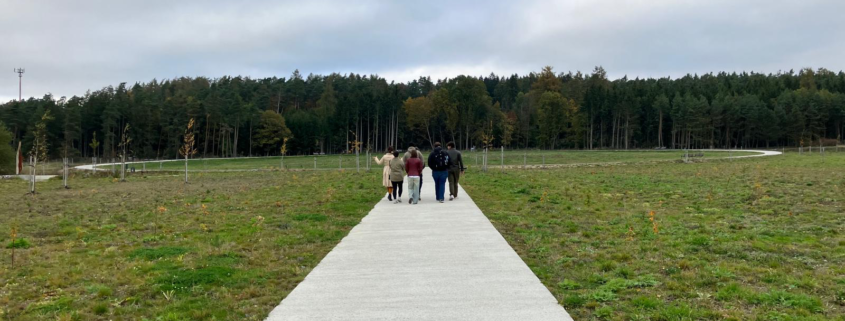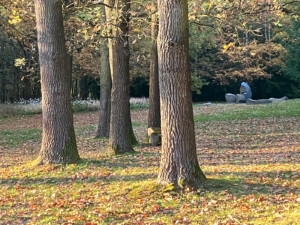Lety U Pisku: The Story of the Porrajamos
By Winter Cameron
500,000. That is the approximation of how many Roma or Sinti that were murdered under the Nazi regime. Approximately half a million people, and yet so few know about the history behind the oppression, subjugation and subsequent extermination of the Roma and Sinti. To the general populous, the history and discrimination against the Roma is wildly unknown or even outright dismissed.
I was one of those people that did not know much about the Roma, especially those that lived in Pre-WWII Czech lands of Bohemia and Moravia. I knew that they were victimized in the Porrajamos, a Romani term describing their genocide under the Nazi regime, literally translated to “The Devouring”. But, I did not know the specifics about their culture or about the labor and concentration camp for the Roma at Lety u Pisku until we visited the memorial and museum located on the former grounds of the camp. On grounds no larger than a small soccer field, as many as 1,300 people were interned during the years 1940-1943. These harsh living and inhumane work conditions led to the spread diseases, malnutrition and death. Over the three years in existence, 335 prisoners died in the camp (241 of these were children) and 540 were sent to Auschwitz and murdered.[1]By the war’s end 90% of the Czech Roma were killed.
The memory of the atrocities against the Roma has long been ignored and unrecognized. After the war, the site of Lety was abandoned until 1973 when a pig farm was opened on the grounds of the former concentration camp. The fact that a pig farm could be opened on the site of a concentration camp shows a lack of care and respect for the fate of the Roma and even outright malice. This was heartbreaking to the families of victims, and to survivors of the travesties that had happened on these grounds. Jan Vrba, survivor who was born in the camp, recounts the horrors and losses, ““I know from my parents that it was a place of cruelty; that starving children were eating raw cabbage from the fields, and that the townspeople from Lety paid no attention to them. Small children were dying on piles of—I don’t want to say it—piles of excrement. My parents managed to protect me and my brother, so that we survived. But I lost my sister here and my grandfather. Lety must be as a memorial!” [2] In the communist period, individual groups’ struggles under Nazi rule were overlooked. For survivors and their families, the trauma stayed within the families; they were unable to discuss what happened at Lety u Pisku because discussions like this were actively discouraged under socialist rule. Anti-Roma bias made it unwelcome or even dangerous to discuss the racist policies against Roma during the Porrajamos even after the end of the war.
After 1989 across Central Europe there was a sort of renaissance during which people began to reflect on the atrocities of WWII in an open and more nuanced way. Discussions about the history of Lety also began in the early 1990s. In 1995, the president of the Czech Republic, Vaclav Havel, placed flowers at the newly opened monument to the Roma victims of Lety. However, the pig farm continued to operate. Successive governments failed to close the pig farm, arguing that they did not have the money to purchase the farm. Roma in the Czech Republic were discriminated against and placed in ghettos.
Beyond the anti-Romani sentiments, there is a question of whether Czech people do not want to admit to the cruelty that the Roma were subjected during World War II due to active participation in Roma persecution. The camp at Lety was established under a law that was passed before the Nazi takeover of Czechoslovakia in 1939. All levels of hierarchy, from the camp commanders to the guards, were entirely Czech, meaning that blame cannot be shifted from the Czechs to the Germans. Czech identity regarding World War II promoted an idea of Czech victimhood and innocence, and that the events that took place in occupied Czech lands were due to Nazi orders.
This past has made it challenging for Czechs to confront this history and recognize their responsibility in Roma suffering. In 2005, the Czech President Vaclav Klaus stated that “Lety was not a concentration camp in a proper sense of the word, but a camp for those who refused to work”[3].
The Czech government finally purchased the pig farm in 2017, paying 17.7 million Euros. The farm finally closed in 2018 when the last pigs were removed. Despite the government’s buying of the pig farm, there was backlash from anti-Roma groups. For example, shortly after the pig farm was closed, someone placed a pig’s head at the memorial opened in 1995. [CITE]
Despite this outrage, plans for the new memorial were still in motion. The memorial site was taken over by the Museum of Romani Culture. The group organized an international competition for the design of the memorial site in 2020. It took four years for the memorial to be built and opened to the public in May 2024.
The memorial includes an outdoor space for reflection and an indoor museum that focuses on Czech Romani culture and the testimonies from survivors of the Romani Holocaust. The outdoor memorial is simple, but effective. Unlike the earlier memorials placed at the site, the current memorial actively names the Roma and Sinti victims and marks the site of the camp. A concrete walkway encircles the place where the camp originally stood. Each slim slab of the walkway contains a name, a date of birth and, if available, a date of death or a deportation date. In contrast to many of the other memorials I have visited over the semester, which were large and monumental, Lety’s memorial was less towering but was still solemn and a place of mourning. Visitors are compelled to contemplate the lives of these people while walking the path or sitting and reflecting. The serene silence of the surrounding forest combined with the modest memorial allows one to be able to reflect on the horrors and be able to process what has happened to this underrepresented group of people.
The museum was interactive, allowing visitors to explore the culture of the Bohemian Roma, which is relatively unknown. The exhibit included photos from personal collections that portrayed Roma life in its richness rather than through the lens of their victimhood. There were also fine China and other personal family belongs. One display contained the page of the writings of a Roma survivor’s memoir. She tried to write the memoir four was never able to complete the work due to the trauma it evoked. While I consider this memorial to be one of the most impactful, I have visited, it has not been met without controversy and struggles.
The museum as a great deal of substance, however, it lacks funding and is operated by a small staff. Currently, it is run by a dedicated group of six people. Beyond investment in the purchase of the farm and some contributions to build the memorial, the Czech government offers little funds to sustain the memorial. The memorial and the exhibit cost 4.35 million euros with money also coming from the Embassy of the Federal Republic of Germany in Prague, and from a grant from Iceland, Liechtenstein and Norway.[4]
Ongoing Roma discrimination in Czechia continues to plague the site. For example, the site is prone to vandalism such as a time when outdoor information boards were defaced with stickers that transformed the information into hard to notice anti-Roma sentiments.
The Czech school system does not find it important to teach the history of the Romani people and the victimhood. Schools do not teach anything about Roma history, and the Romani community is still looked down upon. Therefore, it is important that the memorial stands because it allows for a place for Czechs and others to discover a forgotten and scorned history.
However, despite all the issues and challenges the memorial and museum continue face, it has made an impact on me in ways that I will never forget. The time in Lety allowed me to face a truth about the importance of remembering lesser-known parts of history. Remembering these parts of history allows the victims to be remembered and not to be completely erased, which was the goal the Nazis and other perpetrators. Telling the stories of a community that was almost destroyed is necessary to understanding not only history fully, but also help prevent future tragedies, especially to groups that already are so stigmatized. It is imperative that the memorial keeps standing and tells the stories that so few of the victims were able to tell, And hopefully, telling this story will lead to a hope for a better future.
References
- Albert, Gwendolyn. Rysavy, Zdenek. “Lety u Písku Memorial to the Holocaust of the Roma and Sinti in Bohemia has been visited by almost 6,000 people since opening, unique drone footage shows what there is to see.” September 27th, 2024. https://romea.cz/en/czech-republic/lety-u-pisku-memorial-to-the-holocaust-of-the-roma-and-sinti-in-bohemia-has-been-visited-by-almost-6000-people-since-opening-unique-drone-footage-shows-what-there-is-to-see#google_vignette
- Kenety, Brian. “Lety u Pisku: The politics behind the ‘concentration camp’ pig farm” Radio Prague International. May 19th, 2005. https://english.radio.cz/lety-u-pisku-politics-behind-concentration-camp-pig-farm-8099096
[1] https://romea.cz/en/czech-republic/lety-u-pisku-memorial-to-the-holocaust-of-the-roma-and-sinti-in-bohemia-has-been-visited-by-almost-6000-people-since-opening-unique-drone-footage-shows-what-there-is-to-see
[2] https://english.radio.cz/lety-u-pisku-politics-behind-concentration-camp-pig-farm-8099096
3 https://english.radio.cz/lety-u-pisku-politics-behind-concentration-camp-pig-farm-8099096
[4] https://romea.cz/en/czech-republic/lety-u-pisku-memorial-to-the-holocaust-of-the-roma-and-sinti-in-bohemia-has-been-visited-by-almost-6000-people-since-opening-unique-drone-footage-shows-what-there-is-to-see







